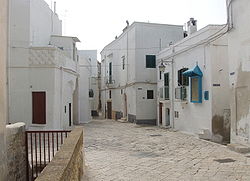Castellaneta
| Castellaneta | |
|---|---|
| Comune | |
| Città di Castellaneta | |

View of the historical centre.
|
|
| Location of Castellaneta in Italy | |
| Coordinates: 40°38′N 16°56′E / 40.633°N 16.933°ECoordinates: 40°38′N 16°56′E / 40.633°N 16.933°E | |
| Country | Italy |
| Region |
|
| Province / Metropolitan city | Taranto (TA) |
| Frazioni | Marina di Castellaneta, Gaudella |
| Government | |
| • Mayor | Giovanni Gugliotti |
| Area | |
| • Total | 239 km2 (92 sq mi) |
| Elevation | 245 m (804 ft) |
| Population (31 December 2013) | |
| • Total | 17,194 |
| • Density | 72/km2 (190/sq mi) |
| Demonym(s) | Castellanetani |
| Time zone | CET (UTC+1) |
| • Summer (DST) | CEST (UTC+2) |
| Postal code | 74011 |
| Dialing code | 099 |
| Patron saint | St. Nicholas and St. Francis of Paola |
| Saint day | December 8 |
| Website | Official website |
Castellaneta is a city and comune in the province of Taranto, in the Apulia region of Southern Italy, about 40 km (25 mi) from Taranto. Located in a territory spanning from the Murgia to the Ionian Sea, characterized by numerous gravina ravines, it is part of the Comunità Montana della Murgia Tarantina (Tarentine Murgia Mountain Community).
Human settlements were present in the area since the Bronze Age (3rd–2nd millennium BC), and it was later probably settled by Sicels, Messapii and Iapyges. According to a theory, a fortified city (Castania in Latin) was founded in 550 and grew in size when the population of neighboring cities fled there from Saracen attacks. Other historians maintain instead that it was a Greek colony which existed until the 8th century. When the Saracens destroyed it, the inhabitants joined in a Castellum Unitum (United Castle) on the hills, whence the current name.
Whatever its origin, Castellaneta was conquered by the Normans in 1064, taken by Duke Robert of Taranto, who expelled its Byzantine inhabitants. At that time, probably, the episcopal see was created. In the 13th century Charles of Anjou turned it first into a fief, and later into a King's city.
In 1503, during the Italian Wars, the citizens pushed back a French occupation force under the Duke of Nemours, in the so-called "Sack of Castellaneta". In 1519 the Spaniards sold it to Flemish feudataries, and thenceforth the city started to decline as secondary center.
...
Wikipedia

